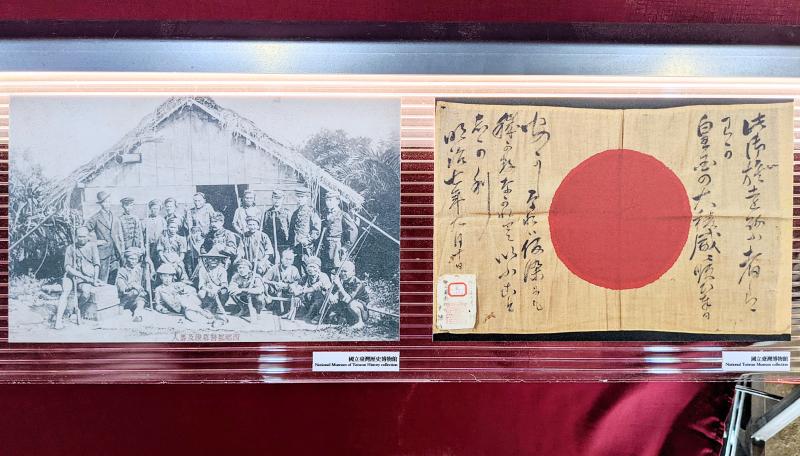A recording of Paiwan singers from Sinevaudjan Village echoes through the exhibition room, the lyrics looking back at the hardships their ancestors suffered to give them the life they have today. Nearly 150 years ago, the village was wiped off the map by the Japanese during the Mudan Incident (牡丹社事件), and it took 36 years for the people to return and rebuild it.
Due to a misunderstanding caused by language and cultural barriers, the ancestors of these singers — along with those from neighboring Kukus — killed 54 shipwrecked Ryukyuan sailors who had accidentally wandered into their territory in 1871. Their actions triggered a Japanese punitive expedition three years later that alarmed the Qing Dynasty, who long-treated Taiwan as a remote backwater that wasn’t worth investing in.
It was a pivotal moment in East Asian history. The Qing started paying more attention to governing and defending Taiwan, while Japan annexed the Kingdom of Ryukyu, its first move in what would be decades of imperial expansion.

Photo: Han Cheung, Taipei Times
Both Paiwan villages were burnt down, and for more than a century, the events were told exclusively from Japanese, Chinese and Western perspectives. Over the past 20 years, experts and locals have been reconstructing a new historical interpretation with the Paiwan as the main subjects. Earlier this month, Mudan Township unveiled new statues of Paiwan leader Aruqu Kavulungan and his son, who were killed in the incident but left out of the conventional narrative.
This display in Huashan 1914 Creative Park is a teaser for later next month’s Listening to Mudan: Formosa Incident of 1874 (聆聽牡丹的聲音) audiovisual exhibition that literally returns the voice to the Paiwan on their traditional land in Pingtung County. The Huashan exhibition closes on June 8, and the Pingtung event opens on June 24.
The Mudan Incident is often connected to the Rover Incident of 1867, which happened further to the south and was also triggered by Paiwan warriors killing shipwrecked foreigners — in this case Americans.

Photo: Han Cheung, Taipei Times
This story was recently dramatized into last year’s hit mini-series Seqalu, drawing much public interest to the history of this area. The research that led to this exhibition is the result of the International Conference on Encounters between Southern Formosa and World, which was held in November 2019, and two years of field research into both incidents by Story Studio (故事).
The Taipei display offers an atmospheric general overview of the events in Chinese and English, but in Pingtung visitors can listen to recordings of Kukus and Sinevaudjan descendants telling their accounts of the incident, which have been passed on orally through the generations, in the Paiwan language and tradition. This is symbolic because the original dispute was caused by cultural and linguistic differences, and most visitors will have to rely on the translations to understand it.
The Pingtung show will also provide transportation and possible tours to several historic sites related to the incident, including one of the main battlefields that can be explored through riverside trails restored earlier this year. Also on the list are the graves of the 54 Ryukuan victims and a memorial to the incident erected by the Japanese in 1935. The Chinese Nationalist Party (KMT) scratched off the memorial’s text after World War II, and it was only restored in 2020.

Photo: Han Cheung, Taipei Times
More details will be announced later next month.

April 14 to April 20 In March 1947, Sising Katadrepan urged the government to drop the “high mountain people” (高山族) designation for Indigenous Taiwanese and refer to them as “Taiwan people” (台灣族). He considered the term derogatory, arguing that it made them sound like animals. The Taiwan Provincial Government agreed to stop using the term, stating that Indigenous Taiwanese suffered all sorts of discrimination and oppression under the Japanese and were forced to live in the mountains as outsiders to society. Now, under the new regime, they would be seen as equals, thus they should be henceforth

Last week, the the National Immigration Agency (NIA) told the legislature that more than 10,000 naturalized Taiwanese citizens from the People’s Republic of China (PRC) risked having their citizenship revoked if they failed to provide proof that they had renounced their Chinese household registration within the next three months. Renunciation is required under the Act Governing Relations Between the People of the Taiwan Area and the Mainland Area (臺灣地區與大陸地區人民關係條例), as amended in 2004, though it was only a legal requirement after 2000. Prior to that, it had been only an administrative requirement since the Nationality Act (國籍法) was established in

With over 80 works on display, this is Louise Bourgeois’ first solo show in Taiwan. Visitors are invited to traverse her world of love and hate, vengeance and acceptance, trauma and reconciliation. Dominating the entrance, the nine-foot-tall Crouching Spider (2003) greets visitors. The creature looms behind the glass facade, symbolic protector and gatekeeper to the intimate journey ahead. Bourgeois, best known for her giant spider sculptures, is one of the most influential artist of the twentieth century. Blending vulnerability and defiance through themes of sexuality, trauma and identity, her work reshaped the landscape of contemporary art with fearless honesty. “People are influenced by

Three big changes have transformed the landscape of Taiwan’s local patronage factions: Increasing Democratic Progressive Party (DPP) involvement, rising new factions and the Chinese Nationalist Party’s (KMT) significantly weakened control. GREEN FACTIONS It is said that “south of the Zhuoshui River (濁水溪), there is no blue-green divide,” meaning that from Yunlin County south there is no difference between KMT and DPP politicians. This is not always true, but there is more than a grain of truth to it. Traditionally, DPP factions are viewed as national entities, with their primary function to secure plum positions in the party and government. This is not unusual